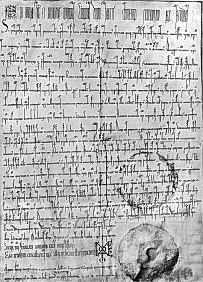





If you are looking at this page without frames, there is more information about medieval writing to be found by going to the home page (framed) or the site map (no frames).
| Diplomas (3) | ||
| Looking at a diploma from around 350 years later than the previous example, we can see that, despite some differences in general appearance, many of the same features are still present. | ||
 |
Diploma of Konrad III, of 1139, confirming to the abbey of St Gall the priveleges they held under former kings and emperors (St Gallen, Stiftsarchiv). (From Steffens1929) | |
| This is evidently a very large document, designed to be imposing. As it is confirming privileges granted by former monarchs, the body of the text contains a list of predecessors, as well as the usual pious sentiments and the details of the grant. There is a list of witnesses after the body of the text. The seal, which was attached to the face of the document, is missing. | ||
 |
The Chrismon symbol is different in form to that of the older document, but the significance is the same. | |
 |
||
| The incredibly compressed heading contains an invocation as well as the name and title of the monarch. It reads In nomine sancte et individue Trinitatis Cunradus divina favente clementia Romanorum rex secundus. | ||
 |
||
| Despite the excess of calligraphic flourishes and the attentuated style of the diplomatic minuscule script of the main text, it is much easier to read than the Merovingian chancery script of the former example, as the underlying letter forms are those of Caroline minuscule. There are many abbreviations, but the squiggly double barrelled papal knot type of abbreviation mark used would seem to be more elaborate and labour intensive than writing the words in full. | ||
 |
||
| The validation clause contains the words Signum domini Cunradi Romanorum regis invictissimi, a rather elaborate royal monogram and an authentication by the chancellor. There is no indication that the king signed or otherwise marked the document, which was authenticated by witnesses, monogram and seal. The mysterious code of Tironian notes is no longer in use. | ||
 |
||
| The document finishes with the date entered in a rather elaborate format, followed by the words In Christo feliciter and then a strangely extended AMEN in which the N is about five times as wide as it is high. | ||
| By the 12th century the use of written record was increasing and becoming systematised. The written word was becoming more significant in its own right than the possession of a symbolic object indicating a grant or pledge. However, in these most weighty and solemn documents the traditional formal elements that identified a document and testified to its importance were still prominent. A diploma still had to look impressive. | ||
| The French National Archives displays a series of important royal diplomas, along with other national documentary treasures. Their website is a bit complicated, but go to the main ARCHIM site, click on the "Recherche par Champs" icon. In the "Type de Document" field of the database type EXACTLY 'diplome (acte solennel du souverain)', including the single quote marks, or select it from the "Lexique" for the field, or copy and paste it from here. Bon chance! | ||
If you are looking at this page without frames, there is more information about medieval writing to be found by going to the home page (framed) or the site map (no frames). |
||